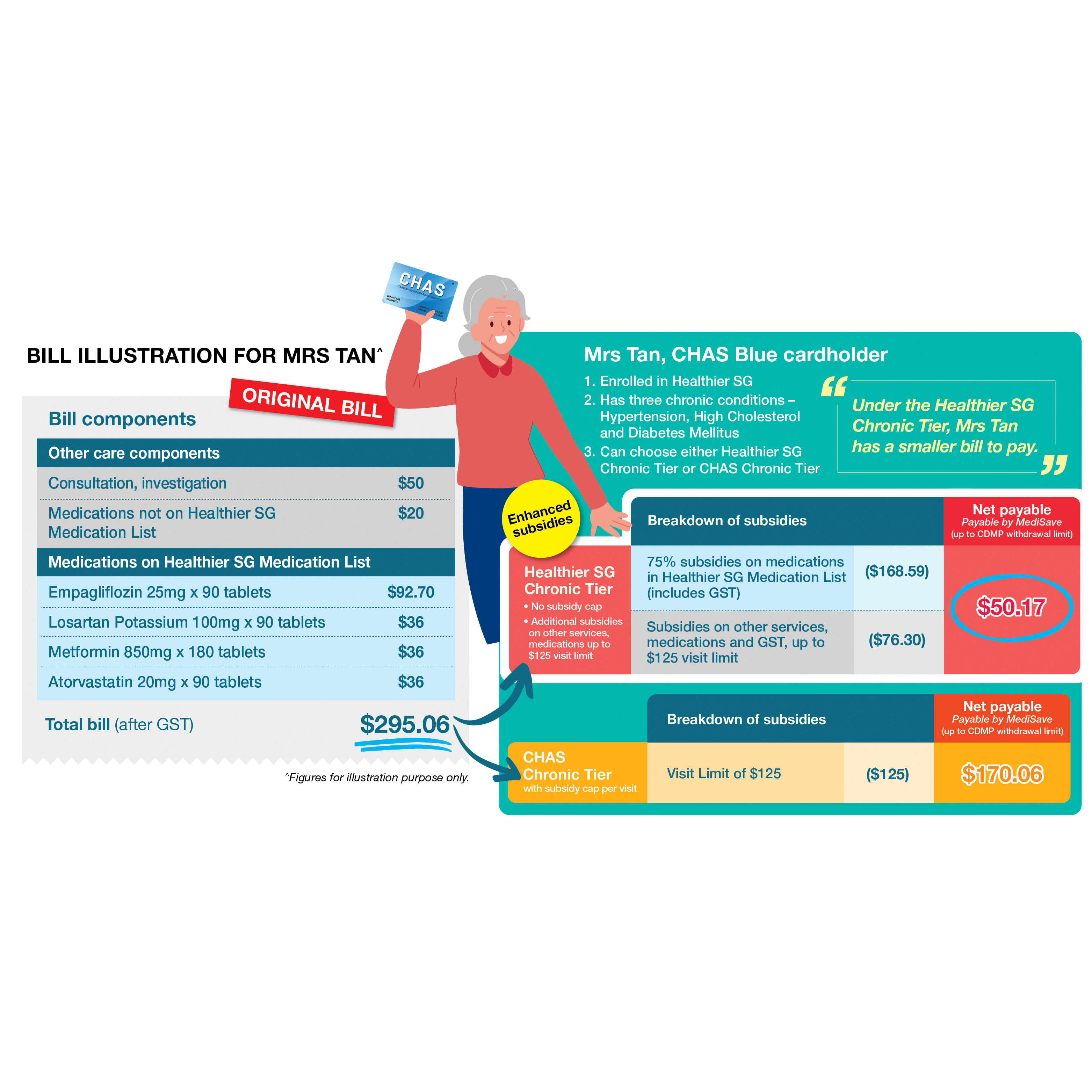Do you, or someone you know, suffer from a chronic medical condition such as hypertension and high cholesterol?
It can be a really tough challenge for anyone to go through, young or old.
As our population ages, there is a growing prevalence of chronic conditions.
In Singapore, chronic conditions increase as our population ages, along with other factors like changes in lifestyle and dietary habits.
According to the National Population Health Survey 2022, the prevalence of conditions such as hypertension and obesity increased from 2019 to 2022:
“Males tended to have higher prevalence of chronic diseases compared with females in general. For all three chronic diseases (diabetes, hypertension and high blood cholesterol), the proportion of residents with chronic diseases increased with age.”
But physical and mental stress are not the only burdens that patients have to bear.
Higher medical bills
Individuals suffering from multiple chronic conditions usually incur higher medical expenses, and this can add a significant financial burden to their expenses.
According to a 2021 study, “Healthcare cost of patients with multiple chronic diseases in Singapore public primary care setting”:
“The median annual cost per capita increased with the number of chronic diseases from one chronic disease of S$277 to five or more chronic diseases of S$895.”
Thankfully, additional help is on the way if you or a loved one suffer from chronic illness(es).
Since 1 Feb 2024, eligible Singaporeans can receive enhanced subsidies under the Healthier SG Chronic Tier subsidy framework at their enrolled GP clinics.
Healthier SG Chronic Tier
Currently, most Singaporeans are well covered by Community Health Assist Scheme (CHAS) subsidies for the cost of chronic medications.
With the new Healthier SG Chronic Tier subsidy framework, Healthier SG-enrolled Community Health Assistance Scheme (CHAS), Pioneer Generation (PG) and Merdeka Generation (MG) cardholders with higher chronic medication needs can get enhanced subsidies at their enrolled GP clinic.
Patients should consult their family doctor on the suitability in utilising the Healthier SG Chronic Tier.
Those who are well covered by their existing CHAS subsidies need not make the switch to the Healthier SG Chronic Tier.
According to Dr Chung Wing Hong, a General Practitioner with Healthier SG clinic Chung and Ee Medical Clinic, the Healthier SG Chronic Tier subsidy does a fair bit to reduce costs.
“Without [Healthier SG Chronic Tier], patients requiring [a] moderate amount of medication could spend approximately S$300 to S$400 per month at family clinics for their medication.
Those obtaining these medications at [Healthier SG] clinics pay only approximately S$100 with Healthier SG Chronic Tier. And these costs could be further reduced with [Healthier SG Chronic Tier] subsidies and MediSave.”
How a patient benefits from the Healthier SG Chronic Tier subsidy
Patients with high medication needs, are likely to benefit from the Healthier SG Chronic Tier.
A global rise in medication costs also contributes to an overall increase in medication prices.
With the Healthier SG Chronic Tier, patients can continue to afford treatment for their chronic conditions.
Let’s recap the subsidies available.
Here’s how CHAS/PG/MG cardholders with high chronic medication needs can benefit from the Healthier SG Chronic Tier at their enrolled Healthier SG clinic:
- Subsidies of up to 87.5 per cent for CHAS/PG/MG cardholders on selected chronic medications, with no dollar cap, at prices comparable to polyclinics. The list of selected chronic medications can be found here.
- Subsidies of up to S$135 per visit and S$360 a year for other care components like consultations and lab tests.
Enrolled residents with chronic conditions under the Chronic Disease Management Programme (CDMP) can also use MediSave to fully pay for their treatment at their enrolled Healthier SG clinics, up to the MediSave withdrawal limit.
They no longer need to co-pay 15 per cent of their bill in cash.
Which framework should I use, Healthier SG Chronic Tier or CHAS subsidies?
You may be wondering which framework you should use or if you can use both at once.
First of all, you can use only one subsidy framework at each visit - either the CHAS Chronic Tier or the Healthier SG Chronic Tier.
You may choose the subsidy tier that would best benefit you based on your medication needs.
The remaining annual subsidy balance will be prorated at your next visit if you switch to another framework, due to the different annual limits.
You should speak to your family doctor to decide which one works best for your health and your financial circumstances.
A smaller bill size for chronic medications
Here’s how the new Healthier SG Chronic Tier can help reduce medical bills for chronic treatment.
Mrs Tan is a CHAS Blue enrollee with Hypertension, High Cholesterol and Diabetes Mellitus.
 Image via Ministry of Health
Image via Ministry of Health
As you can see, with the Healthier SG Chronic Tier, Mrs Tan has a lower net payable.
Of course, these are just for illustration purposes, and your own consultation, investigation or medication charges may differ.
But it gives you an idea of how the Healthier SG Chronic Tier can help keep chronic treatment affordable.
One doctor’s experience
For Dr Chung, his patients have benefited from the scheme, especially those who have transferred from polyclinics into his care.
“Now patients can obtain chronic medications at similar affordable prices, and at the convenience of their family GP located near them,” he added.
The Healthier SG Chronic Tier has not only helped patients economically, but logistically as well.
For Dr Chung, there has been an increase in patients transitioning from polyclinic to visiting his clinic.
His patients have also found it more convenient to visit him with shorter queue times and they need not wait to get an appointment.
Dr Chung observed that patients prefer to have a single doctor managing their chronic conditions rather than having a few different doctors to manage them.
While the care protocols are the same, the patient-doctor relationship is important in achieving better health outcomes.
This is a sponsored article brought to you by the Ministry of Health.
Top photo via Laurynas Me on Unsplash
If you like what you read, follow us on Facebook, Instagram, Twitter and Telegram to get the latest updates.

